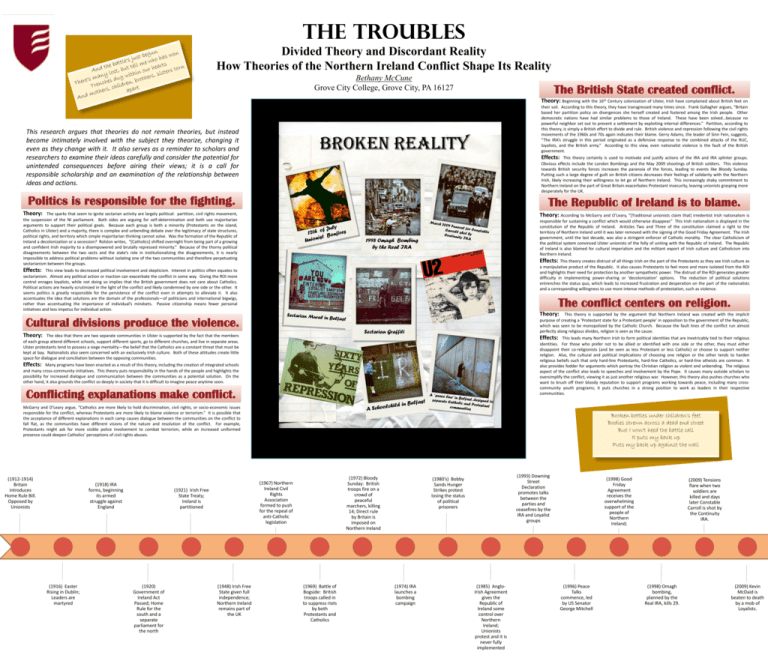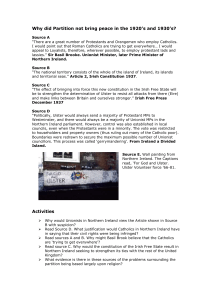Divided Theory and Discordant Reality How Theories of the
advertisement

The Troubles Divided Theory and Discordant Reality How Theories of the Northern Ireland Conflict Shape Its Reality Bethany McCune Grove City College, Grove City, PA 16127 The British State created conflict. Theory: Beginning with the 16th Century colonization of Ulster, Irish have complained about British feet on This research argues that theories do not remain theories, but instead become intimately involved with the subject they theorize, changing it even as they change with it. It also serves as a reminder to scholars and researchers to examine their ideas carefully and consider the potential for unintended consequences before airing their views; it is a call for responsible scholarship and an examination of the relationship between ideas and actions. their soil. According to this theory, they have transgressed many times since. Frank Gallagher argues, “Britain based her partition policy on divergences she herself created and fostered among the Irish people. Other democratic nations have had similar problems to those of Ireland. These have been solved…because no powerful neighbor set out to prevent a settlement by exploiting internal differences.” Partition, according to this theory, is simply a British effort to divide and rule. British violence and repression following the civil rights movements of the 1960s and 70s again indicates their blame. Gerry Adams, the leader of Sinn Fein, suggests, “The IRA’s struggle in this period originated as a defensive response to the combined attacks of the RUC, loyalists, and the British army.” According to this view, even nationalist violence is the fault of the British government. Broken Reality Effects: This theory certainly is used to motivate and justify actions of the IRA and IRA splinter groups. Obvious effects include the London Bombings and the May 2009 shootings of British soldiers. This violence towards British security forces increases the paranoia of the forces, leading to events like Bloody Sunday. Putting such a large degree of guilt on British citizens decreases their feelings of solidarity with the Northern Irish, likely increasing their willingness to let go of Northern Ireland. This increasingly shaky commitment to Northern Ireland on the part of Great Britain exacerbates Protestant insecurity, leaving unionists grasping more desperately for the UK. Politics is responsible for the fighting. The Republic of Ireland is to blame. Theory: The sparks that seem to ignite sectarian activity are largely political: partition, civil rights movement, the suspension of the NI parliament. Both sides are arguing for self-determination and both use majoritarian arguments to support their political goals. Because each group is both a minority (Protestants on the island, Catholics in Ulster) and a majority, there is complex and unbending debate over the legitimacy of state structures, political rights, and territory which simple majoritarian thinking cannot solve. Was the formation of the Republic of Ireland a decolonization or a secession? Rolston writes, “*Catholics+ shifted overnight from being part of a growing and confident Irish majority to a disempowered and brutally repressed minority.” Because of the thorny political disagreements between the two sects and the state’s role in institutionalizing the disagreements, it is nearly impossible to address political problems without isolating one of the two communities and therefore perpetuating sectarianism between the groups. Theory: According to McGarry and O’Leary, “*Traditional unionists claim that] irredentist Irish nationalism is responsible for sustaining a conflict which would otherwise disappear.” This Irish nationalism is displayed in the constitution of the Republic of Ireland. Ariticles Two and Three of the constitution claimed a right to the territory of Northern Ireland until it was later removed with the signing of the Good Friday Agreement. The Irish government, until the last decade, was also a stringent enforcer of Catholic morality. The clear Catholicism of the political system convinced Ulster unionists of the folly of uniting with the Republic of Ireland. The Republic of Ireland is also blamed for cultural imperialism and the militant export of Irish culture and Catholicism into Northern Ireland. 1998 Omagh Bombing by the Real IRA Effects: This theory creates distrust of all things Irish on the part of the Protestants as they see Irish culture as a manipulative product of the Republic. It also causes Protestants to feel more and more isolated from the ROI and highlights their need for protection by another sympathetic power. The distrust of the ROI generates greater difficulty in implementing power-sharing or ‘decolonization’ options. The reduction of political solutions entrenches the status quo, which leads to increased frustration and desperation on the part of the nationalists and a corresponding willingness to use more intense methods of protestation, such as violence. Effects: This view leads to decreased political involvement and skepticism. Interest in politics often equates to sectarianism. Almost any political action or inaction can exacerbate the conflict in some way. Giving the ROI more control enrages loyalists, while not doing so implies that the British government does not care about Catholics. Political actions are heavily scrutinized in the light of the conflict and likely condemned by one side or the other. It seems politics is greatly responsible for the persistence of the conflict even in attempts to alleviate it. It also accentuates the idea that solutions are the domain of the professionals—of politicians and international bigwigs, rather than accentuating the importance of individual’s mindsets. Passive citizenship means fewer personal initiatives and less impetus for individual action. The conflict centers on religion. Theory: This theory is supported by the argument that Northern Ireland was created with the implicit purpose of creating a ‘Protestant state for a Protestant people’ in opposition to the government of the Republic, which was seen to be monopolized by the Catholic Church. Because the fault lines of the conflict run almost perfectly along religious divides, religion is seen as the cause. Cultural divisions produce the violence. Sectarian Graffiti Theory: The idea that there are two separate communities in Ulster is supported by the fact that the members of each group attend different schools, support different sports, go to different churches, and live in separate areas. Ulster protestants tend to possess a siege mentality—the belief that the Catholics are a constant threat that must be kept at bay. Nationalists also seem concerned with an exclusively Irish culture. Both of these attitudes create little space for dialogue and conciliation between the opposing communities. Effects: This leads many Northern Irish to form political identities that are inextricably tied to their religious identities. For those who prefer not to be allied or identified with one side or the other, they must either disappoint their co-religionists (and be seen as less Protestant or less Catholic) or choose to support neither religion. Also, the cultural and political implications of choosing one religion or the other tends to harden religious beliefs such that only hard-line Protestants, hard-line Catholics, or hard-line atheists are common. It also provides fodder for arguments which portray the Christian religion as violent and unbending. The religious aspect of the conflict also leads to speeches and involvement by the Pope. It causes many outside scholars to oversimplify the conflict, viewing it as just another religious war. However, this theory also pushes churches who want to brush off their bloody reputation to support programs working towards peace, including many crosscommunity youth programs; it puts churches in a strong position to work as leaders in their respective communities. Effects: Many programs have been enacted as a result of this theory, including the creation of integrated schools and many cross-community initiatives. This theory puts responsibility in the hands of the people and highlights the possibility for increased dialogue and communication between the communities as a potential solution. On the other hand, it also grounds the conflict so deeply in society that it is difficult to imagine peace anytime soon. Conflicting explanations make conflict. McGarry and O’Leary argue, “Catholics are more likely to hold discrimination, civil rights, or socio-economic issues responsible for the conflict, whereas Protestants are more likely to blame violence or terrorism.” It is possible that the acceptance of different explanations in each camp causes dialogue between the communities on the conflict to fall flat, as the communities have different visions of the nature and resolution of the conflict. For example, Protestants might ask for more visible police involvement to combat terrorism, while an increased uniformed presence could deepen Catholics’ perceptions of civil rights abuses. (1912-1914) Britain introduces Home Rule Bill. Opposed by Unionists (1918) IRA forms, beginning its armed struggle against England (1916) Easter Rising in Dublin; Leaders are martyred (1972) Bloody Sunday: British troops fire on a crowd of peaceful marchers, killing 14; Direct rule by Britain is imposed on Northern Ireland (1967) Northern Ireland Civil Rights Association formed to push for the repeal of anti-Catholic legislation (1921) Irish Free State Treaty; Ireland is partitioned (1920) Government of Ireland Act Passed; Home Rule for the south and a separate parliament for the north Broken bottles under children's feet Bodies strewn across a dead end street But I won't heed the battle call It puts my back up Puts my back up against the wall (1948) Irish Free State given full independence; Northern Ireland remains part of the UK (1969) Battle of Bogside: British troops called in to suppress riots by both Protestants and Catholics (1993) Downing Street Declaration promotes talks between the parties and ceasefires by the IRA and Loyalist groups (1980’s) Bobby Sands Hunger Strikes protest losing the status of political prisoners (1974) IRA launches a bombing campaign (1985) AngloIrish Agreement gives the Republic of Ireland some control over Northern Ireland; Unionists protest and it is never fully implemented (1998) Good Friday Agreement receives the overwhelming support of the people of Northern Ireland; (1996) Peace Talks commence, led by US Senator George Mitchell (2009) Tensions flare when two soldiers are killed and days later Constable Carroll is shot by the Continuity IRA. (1998) Omagh bombing, planned by the Real IRA, kills 29. (2009) Kevin McDaid is beaten to death by a mob of Loyalists.







